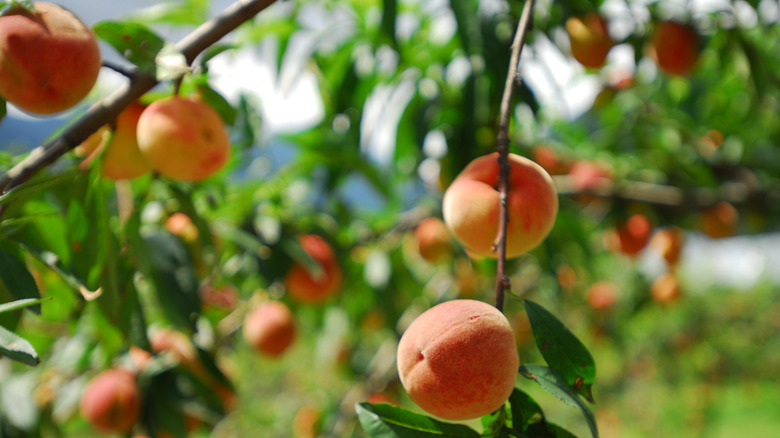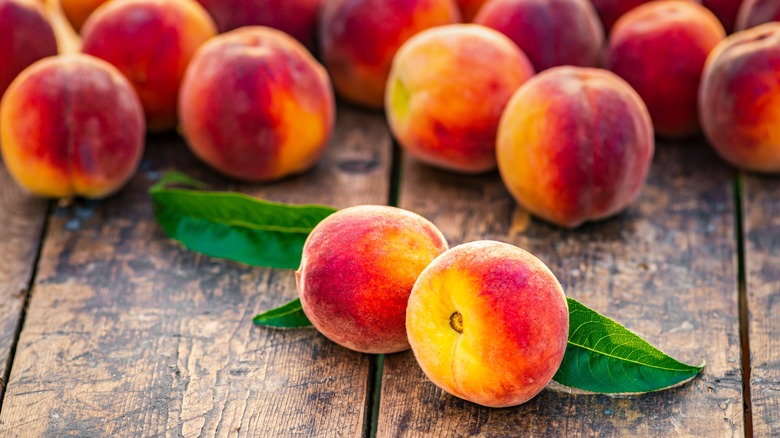Here's Which State Grows The Most Peaches (It's Not Where You Think)
Ask anyone which U.S. state produces the most peaches, and they'll probably confidently say it's Georgia. It makes sense since peaches are the official state fruit, they're featured on car license plates, and there are roughly 70 roads named after them in the state. But it turns out that Georgia isn't even close to growing the most peaches in America. This sweet fruit is grown in 33 different states, and California produces more than the rest of them combined.
Love grilled peaches and ice cream or an old-fashioned peach cobbler? It turns out that you should be thanking the Golden State for supplying most of the country with them. California farmers grow an almost ridiculous number of peaches, but let's look at how they stack up against Georgia. In 2022, Georgia farms produced around 24,800 tons of peaches, which sounds like a lot. California? They were responsible for 475,000 tons. And those numbers have actually been on the decline. In 2014, the state's hard-working farmers harvested a whopping 620,000 tons. Georgia can't even hold a candle to that.
California's history has always included peaches
If you love peaches, you're not alone. Historians say that a love for the fruit goes back around 3,000 years when they were a favorite among China's ruling elite. They were carried to the New World on Christopher Columbus's journey, and when settlers began putting down roots in California in earnest, they found that these fruits — native to Asia — were already there. So, how'd that happen?
Peach trees were first planted on the West Coast by Spanish missionaries, and by 1792, they were well established in California missions. They also got a boost from a Russian explorer named K.T. Khlebnikov, who was a representative of the Russian-American Company and whose journals still provide some of the best information on early 19th-century Russian interests in the U.S. He's also one of the people who planted peach trees in California, which ended up being harvested in the 1820s.
Historically, California has been pretty perfect for peaches. It has the ideal climate and rich soils that have supported the peach-growing industry for well over two centuries and, while it's still leading the country in peach production, its long history allows for a unique insight into climate change. Heat and drought were taking their toll, with problems compounded by economic factors. But, while tonnage may be down, California is still leading the way.
Why is Georgia so firmly associated with peaches?
As we mentioned, the peach is Georgia's official state fruit, and, hilariously, California doesn't even have an official state food. Finding out that it's so far behind California in peach production means that the next logical question is why it's so proud of its connection to peaches. For that we need to backtrack a bit because Georgia became known as the Peach State post-Civil War. Georgia's connection to the fruit dates back to 1571, and it would take nearly 300 years for Georgia peaches to be sold in northern states. That was about the same time southern horticulturists Louis and Prosper Berckmans purchased the land now known as Fruitland. The Berckmans wanted to promote them as an environmentally friendly crop, and it just happened to coincide with the end of slavery.
Peaches' harvest season dovetailed with the cotton harvest and, according to what Kennesaw State University assistant professor of history William Thomas Okie told NPR, the gentlemen farmers of the South saw peaches as the perfect crop to promote Georgia as a new and forward-thinking state, even if that wasn't precisely true. Peaches were European, exotic, cultured, and classy while avoiding a stigma closely associated with their other staple crop. "Cotton had all these associations with poverty and slavery," Okie explained. Peaches? Not so much, and once farmers, landowners, and entire towns started promoting their peaches, the rest is history that's still evident today.


